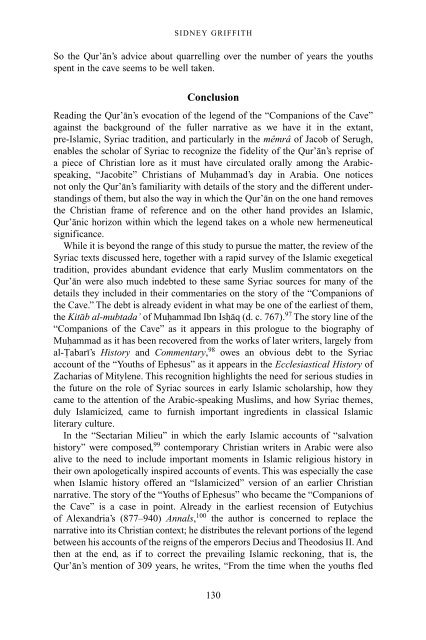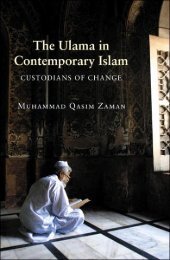The Qur'an in its historical context (pdf - Islam and Christian-Muslim ...
The Qur'an in its historical context (pdf - Islam and Christian-Muslim ...
The Qur'an in its historical context (pdf - Islam and Christian-Muslim ...
You also want an ePaper? Increase the reach of your titles
YUMPU automatically turns print PDFs into web optimized ePapers that Google loves.
SIDNEY GRIFFITH<br />
So the Qur’an’s advice about quarrell<strong>in</strong>g over the number of years the youths<br />
spent <strong>in</strong> the cave seems to be well taken.<br />
Conclusion<br />
Read<strong>in</strong>g the Qur’an’s evocation of the legend of the “Companions of the Cave”<br />
aga<strong>in</strong>st the background of the fuller narrative as we have it <strong>in</strong> the extant,<br />
pre-<strong>Islam</strong>ic, Syriac tradition, <strong>and</strong> particularly <strong>in</strong> the mêmrâ of Jacob of Serugh,<br />
enables the scholar of Syriac to recognize the fidelity of the Qur’an’s reprise of<br />
a piece of <strong>Christian</strong> lore as it must have circulated orally among the Arabicspeak<strong>in</strong>g,<br />
“Jacobite” <strong>Christian</strong>s of Muhammad’s day <strong>in</strong> Arabia. One notices<br />
not only the Qur’an’s familiarity with details of the story <strong>and</strong> the different underst<strong>and</strong><strong>in</strong>gs<br />
of them, but also the way <strong>in</strong> which the Qur’an on the one h<strong>and</strong> removes<br />
the <strong>Christian</strong> frame of reference <strong>and</strong> on the other h<strong>and</strong> provides an <strong>Islam</strong>ic,<br />
Qur’anic horizon with<strong>in</strong> which the legend takes on a whole new hermeneutical<br />
significance.<br />
While it is beyond the range of this study to pursue the matter, the review of the<br />
Syriac texts discussed here, together with a rapid survey of the <strong>Islam</strong>ic exegetical<br />
tradition, provides abundant evidence that early <strong>Muslim</strong> commentators on the<br />
Qur’an were also much <strong>in</strong>debted to these same Syriac sources for many of the<br />
details they <strong>in</strong>cluded <strong>in</strong> their commentaries on the story of the “Companions of<br />
the Cave.” <strong>The</strong> debt is already evident <strong>in</strong> what may be one of the earliest of them,<br />
the Kitab al-mubtada’ of Muhammad Ibn Ishaq (d. c. 767). 97 <strong>The</strong> story l<strong>in</strong>e of the<br />
“Companions of the Cave” as it appears <strong>in</strong> this prologue to the biography of<br />
Muhammad as it has been recovered from the works of later writers, largely from<br />
al-Tabari’s History <strong>and</strong> Commentary, 98 owes an obvious debt to the Syriac<br />
account of the “Youths of Ephesus” as it appears <strong>in</strong> the Ecclesiastical History of<br />
Zacharias of Mitylene. This recognition highlights the need for serious studies <strong>in</strong><br />
the future on the role of Syriac sources <strong>in</strong> early <strong>Islam</strong>ic scholarship, how they<br />
came to the attention of the Arabic-speak<strong>in</strong>g <strong>Muslim</strong>s, <strong>and</strong> how Syriac themes,<br />
duly <strong>Islam</strong>icized, came to furnish important <strong>in</strong>gredients <strong>in</strong> classical <strong>Islam</strong>ic<br />
literary culture.<br />
In the “Sectarian Milieu” <strong>in</strong> which the early <strong>Islam</strong>ic accounts of “salvation<br />
history” were composed, 99 contemporary <strong>Christian</strong> writers <strong>in</strong> Arabic were also<br />
alive to the need to <strong>in</strong>clude important moments <strong>in</strong> <strong>Islam</strong>ic religious history <strong>in</strong><br />
their own apologetically <strong>in</strong>spired accounts of events. This was especially the case<br />
when <strong>Islam</strong>ic history offered an “<strong>Islam</strong>icized” version of an earlier <strong>Christian</strong><br />
narrative. <strong>The</strong> story of the “Youths of Ephesus” who became the “Companions of<br />
the Cave” is a case <strong>in</strong> po<strong>in</strong>t. Already <strong>in</strong> the earliest recension of Eutychius<br />
of Alex<strong>and</strong>ria’s (877–940) Annals, 100 the author is concerned to replace the<br />
narrative <strong>in</strong>to <strong>its</strong> <strong>Christian</strong> <strong>context</strong>; he distributes the relevant portions of the legend<br />
between his accounts of the reigns of the emperors Decius <strong>and</strong> <strong>The</strong>odosius II. And<br />
then at the end, as if to correct the prevail<strong>in</strong>g <strong>Islam</strong>ic reckon<strong>in</strong>g, that is, the<br />
Qur’an’s mention of 309 years, he writes, “From the time when the youths fled<br />
130



